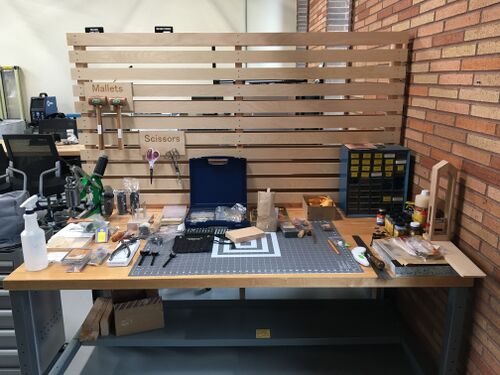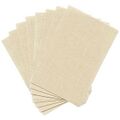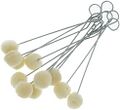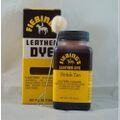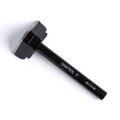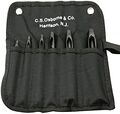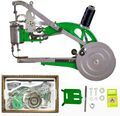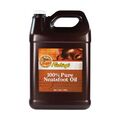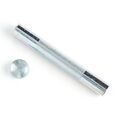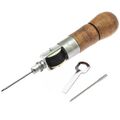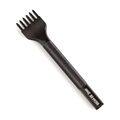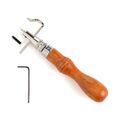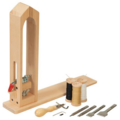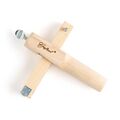Difference between revisions of "Leatherworking Station"
| Line 132: | Line 132: | ||
Second, punch your stitching holes using a stitching chisel. Use the rawhide hammer to pound the stitching chisel with a scrap wood block underneath to avoid damaging the table. The main trick to this technique is to make sure that your chisel is perfectly perpendicular to the leather. A slight angle one way or the other will make it so the stitching on the backside doesn’t line up. This is especially a problem on thicker projects, like belts. | Second, punch your stitching holes using a stitching chisel. Use the rawhide hammer to pound the stitching chisel with a scrap wood block underneath to avoid damaging the table. The main trick to this technique is to make sure that your chisel is perfectly perpendicular to the leather. A slight angle one way or the other will make it so the stitching on the backside doesn’t line up. This is especially a problem on thicker projects, like belts. | ||
| + | |||
| + | How much thread do I need? This depends greatly on the thickness of the leather and the style of stitch. For saddle stitching, it's recommended to cut thread that is between 4-lengths (for thinner projects) and 8-lengths (for thicker projects) of the total stitching length on the piece of leather. How tight you pull the thread will also make a big difference in how much thread is needed. No need to pull with all your might, but definitely don't leave your stitches loose. | ||
Now to the hard part: saddle stitching. Once you have the needles through the first hole, take the needle on the left side and push it through the leather. Then, with the right needle, come behind the left needle to make a cross. Next, with the right needle still behind the left needle, pull the left needle through and rotate your hand toward you so that the left needle is now facing you and the right needle is facing the stitching holes. | Now to the hard part: saddle stitching. Once you have the needles through the first hole, take the needle on the left side and push it through the leather. Then, with the right needle, come behind the left needle to make a cross. Next, with the right needle still behind the left needle, pull the left needle through and rotate your hand toward you so that the left needle is now facing you and the right needle is facing the stitching holes. | ||
| Line 143: | Line 145: | ||
<gallery> | <gallery> | ||
| − | File:Thread1.jpg | + | File:Thread1.jpg|Cut the thread to the needed length |
| − | File:Thread2.jpg | + | File:Thread2.jpg|Roll or flatten the tip of the thread to put it through the eye of the needle |
| − | File:Thread3.jpg | + | File:Thread3.jpg|With the thread extending 1-2" beyond the tip of the needle, pierce the center of the thread with the needle |
| − | File:Thread4.jpg | + | File:Thread4.jpg|Pull the pierced section of thread beyond the eye of the needle to create a knot |
| − | File:Thread5.jpg | + | File:Thread5.jpg|Pull from both sides of the thread to tighten the knot |
| − | File:Thread6.jpg | + | File:Thread6.jpg|Slide the knot to the top of the eye, and now you are ready to stitch |
</gallery> | </gallery> | ||
Revision as of 12:14, 18 February 2022
Make: Various
Model: Various
Serial Number: Various
Ace: Dane Ziegler (dziegler22@georgefox.edu).
Location: The Vault
Description
Many leatherworking techniques do not require a high level of skill to get started. With a basic familiarity of the tools and what each one is used for, a large variety of leather projects become accessible. The main goal of this training course is to show you a wide range of tools and give you an opportunity to practice with them.
Documentation
Terminology
Vegetable-tanned Leather is tanned with natural vegetable tannins to alter the protein structure of the hide, causing it to become leather. This type of leather typically takes a longer amount of time to create. Approximately 10% of all leather is vegetable-tanned.
Chrome-tanned Leather uses chemicals to tan and is a faster, less costly process. Chrome-tanned leather comes in a large variety of colors and is often less stiff than untreated vegetable-tanned leather. Approximately 90% of all leather is chrome-tanned. Do not laser cut chrome-tanned leather.
For an excellent explanation on the differences between vegetable-tanned leather and chrome-tanned leather, watch this video from Gentleman's Gazette.
Awl - An awl is a tool with a metal point used for marking, piercing, punching, or sewing leather.
Burnishing Cloth - A canvas-like material that will burnish (to seal, smooth, and make shiny through rubbing friction) the edges of your leather workpiece. These can also remove char after using a laser engraver.
Wood Burnisher - A wooden piece with grooves that is used to smooth and harden the edges of leather through applied friction and pressure.
Dobbers - Dobbers are used to apply oil or dye to your leather workpiece.
Leather Dye - Leather dye will stain your vegetable-tanned leather. We have a variety of colors available.
Edge Beveler - An edge beveler is a tool with a metal blade that is used to remove the square corners from the edges of leather goods.
End Punch - An end punch is used to cut smooth and clean tips on belts and straps up to 2" wide.
Hole Punch Set and Revolving Punch - Leather punches are hole punches specifically for making holes of various sizes in leather. They are great for setting rivets or making holes in belts and collars.
Manual Leather Sewing Machine - A heavy duty, hand-cranked sewing machine. Please receive proper training on threading and operation before using.
Neatsfoot Oil - Neatsfoot oil is an oil finish for leather that comes from the shin bones and feet of cattle. It's used to soften, condition, and preserve leather products.
Rawhide Hammer - A rawhide hammer (also called a leather maul) is a striking tool used for stamping, tooling, setting rivets, and more.
Rivet Setter - A set of tools used for setting rivets in leather.
Leather Shears - Heavy duty scissors that cut through leather quite easily.
Stitching Chisel - Stitching chisels are tools that are used for marking and creating holes in leather--usually for hand-sewing purposes. They are built with equally spaced metal points.
Stitching Groover - A tool that marks a groove around the edge of your workpiece by applying downward pressure as you drag the tool. The guide can be adjusted for different depths of inset grooves.
Stitching Pony - A device that keeps leather securely in place while hand-sewing, stitching, or lacing.
Strap Cutter - A tool designed to cut leather strips up to 4" wide as the leather is pushed/pulled across a small blade.
Swivel Knife - A swivel knife is used to outline and cut a design into the surface of leather as an initial stage to tooling the leather with decorations.
Training
Operation
Collectively, the leatherworking station is treated as a single piece of equipment--comprised of an assortment of tools. Each tool has a specific purpose, and half of the battle is just knowing what each tool does. The General Procedure section explains the process of various techniques you'll perform in the demonstration.
Demonstration
The demonstration for the leatherworking station will be an overview of the tools and techniques. Take a piece of scrap leather and perform the following actions:
- Take the strap cutter and cut a 0.5" strip of leather
- Practice punching a couple holes with either the rotary punch or the hole punch set
- Set the stitching groover to run a groove around the edges of your leather strip
- Use the edge beveler to round the top and bottom edges
- Burnish the edges of your leather strip with the wood burnisher, the burnishing cloth, or the burnishing attachment for the Dremel tool
- Prepare the leather for some hand-sewing by puncturing it with an awl or a stitching chisel
- Secure your leather strip in the stitching pony and attempt to sew using a saddle stitch in a few of the stitching holes you made
There are many more skills associated with leatherworking; this demonstration is only designed to cover the basics.
General Procedure
Cutting Leather is one of the first things you’ll do for your project. And this is something that’s pretty easy, but there’s a right way to cut and a not-so-right way. Because cutting out the leather is generally the first step in making a leather item and your cuts affect the difficulty of the steps that follow. Clean cuts ensure that burnishing is easy and your stitching lines are straight. Getting a clean cut is all about scoring, using a ruler that won’t slip and having a sharp knife or rotary cutting tool.
Hand-stitching is one of the harder skills to learn, but it's still easy to pick up. Stitching a leather project together is a multi-step process. It involves marking out your stitching lines, punching your stitching holes, and finally saddle stitching the item together. Saddle stitching is a hand stitch that is widely used in leatherworking due to its durability. See the steps below along with the video to learn how to saddle stitch.
First, mark your stitching lines with a groover. If you’re not sure how far in to set your stitch, a general rule of thumb is to have the distance between the stitching and the edge be the same as the thickness of the edge.
Second, punch your stitching holes using a stitching chisel. Use the rawhide hammer to pound the stitching chisel with a scrap wood block underneath to avoid damaging the table. The main trick to this technique is to make sure that your chisel is perfectly perpendicular to the leather. A slight angle one way or the other will make it so the stitching on the backside doesn’t line up. This is especially a problem on thicker projects, like belts.
How much thread do I need? This depends greatly on the thickness of the leather and the style of stitch. For saddle stitching, it's recommended to cut thread that is between 4-lengths (for thinner projects) and 8-lengths (for thicker projects) of the total stitching length on the piece of leather. How tight you pull the thread will also make a big difference in how much thread is needed. No need to pull with all your might, but definitely don't leave your stitches loose.
Now to the hard part: saddle stitching. Once you have the needles through the first hole, take the needle on the left side and push it through the leather. Then, with the right needle, come behind the left needle to make a cross. Next, with the right needle still behind the left needle, pull the left needle through and rotate your hand toward you so that the left needle is now facing you and the right needle is facing the stitching holes.
Finally, put the right needle through the same hole you just pulled the left needle through. If you used a diamond chisel, each hole will be a diamond shape. This means that each hole has a high point and a low point. For your stitching to look uniform you need to consistently put the right needle back through the hole at the same point in the diamond, ideally the point of the diamond that is closest to you (assuming you are stitching towards yourself using the stitching pony). Once the needle is through, pull both tight. At that point, you’ve finished your first saddle stitch. On to the next one. Once you’ve completed your entire stitching line, you’ll need to backstitch. Back stitching is a saddle stitch that goes backwards 2-3 holes to make sure the thread won’t come loose.
Here is a video that shows the saddle stitching technique.
Threading a Needle is actually a skill too. Here's a quick aside on how to do it with waxed thread. Click on each image to see more detail.
Once your project is stitched together, making sure to finish your edges will give your project a professional look. There are multiple ways to edge finish, the three main ways being: burnishing, edge painting, and edge turning. Burnishing is probably the easiest and yields some great results. This process finishes the edges by melting the loose fibers together with heat created through friction. Basically, that just means you rub the edges with a piece of canvas until it looks good. A simple burnishing process includes: beveling edges, sanding them, dying them, burnishing them with a piece of canvas cloth, and then finishing the edge with beeswax. Burnishing Step 1First you’ll need to bevel your edges. The reason for this is that the surface of the leather will start to fold over as you sand the edge. Beveling basically removes that part that would fold over. Beveling is super easy. All you need to do is run the beveler along the edge with a moderate amount of force.
Next, you’ll need to get the edges nice and smooth. Generally, I hit it with a couple of grits of sandpaper. First, start with a 200 grit sandpaper, this will even out any part of the edge that is not flat with the rest. Then, sand off loose fibers with a 600 grit sandpaper.
Once the edges are smoothed out, it’s time to dye the edge. I apply the dye with a wool dauber. But, dying the edge isn’t something you have to do. If you want your edge to be a natural color, then don’t dye it. Typically though, I will dye the edge with the same color I used to dye the surface. When you burnish the edges will naturally darken, so using the same dye provides a darker shade of the same color, which always looks good.
After the edges have been dyed, it’s time to actually burnish. To do this, dip your finger in water and lightly wet the edges. Make sure not to soak the edges though. Leather becomes very pliable when soaked and can be molded. This is great for other things, but not so much when your burnishing. Once you’ve put water on the edges, rub a canvas cloth across it briskly until the edges start to darken and shine. You’ll know you’re done when you start to hear a tacky sound.
And finally, apply some glycerin soap or beeswax to the edge. This helps keep the leather water-resistant and makes the edges look dang good. After putting on the beeswax, make sure to buff the edges again with a piece of canvas. Then you’re done.
Dyeing leather is tricky (Yes. I’m still working on it.) Getting a nice even coat of dye on leather takes not only the know how, but also the skill that comes with lots and lots of practice. After trying out a number of different ways to dye leather, this is the one that I’m most happy with.
STEP 1: PREP THE LEATHER This is what your hands will look like if you don't put on gloves. People will look at your weird. This is what your hands will look like if you don't put on gloves. People will look at your weird.
Put on Gloves
Sure this is obvious, but I cannot tell you the number of times I thought "I’ll just be careful and won’t get anything on my hands.” That has not once worked out for me. Don’t be dumb like me. Wear gloves.
This is what it will look like if you put gloves on. This is better. This is what it will look like if you put gloves on. This is better.
Ventilate the Room
This isn’t an insta-death situation, but the fumes of the oil dyes are seriously not good for your to be hanging out in for a few hours. So figure out some way to ventilate the room. A fan in the window does the trick.
Select the Correct Leather.
You can dye any un-dyed veg tanned leather. In fact, you can probably dye pre-dyed veg tanned leather… but why? (serious though, if you do this, just be aware that there are waxes on top of finished leathers that will not allow the dye to penetrate the leather well). That said, there’s not a ton of considerations when it comes to choosing leather. Just know, that if you’re using 100% top grain leather, you’re going to see all the marks and different shades on the leather. 100% top grain leather is great for quality, but it does mean that the top layer (and imperfections that come with) have not be removed. This is going to really show up when you use a dyeing using this method (instead of the method most industrial places uses, which involves submerging the leather completely in dye. This takes a lot of dye, but is more penetrating and offers a smoother finish). So, if you use an inexpensive piece of leather, that has more marks and inconsistencies, just know that it is going to show up no matter how great you are at dying.
View fullsize From left to right: Water Based Dye, Oil Based Dye, Dye Reducer, and finally Tan-Kote Leather Finish From left to right: Water Based Dye, Oil Based Dye, Dye Reducer, and finally Tan-Kote Leather Finish
Wipe Down the Leather
If your leather has been in your shop for more than a day, there’s a good chance crap has accumulated on it (especially if you’re sanding your edges). Wiping it down quickly with a dry rag prior to dying will help create an even coat. Some suggest using a deglazer on the leather, which will remove any oils that have gotten on the leather from things like your hands. I’ve not used this before, but I’ve seen it recommended many times. Fiebings offers this.
View fullsize Loading up the sponge with dye. Loading up the sponge with dye.
Cut Your Dyes
I use Fiebings Pro Dye when using an oil based dye and Tandy's Eco-Flo for water based dyes. I like the Pro Dye from Fiebings. Out of everything I’ve used it’s given the most consistent coat, but both work well. I do really suggest cutting it though. If it's an oil dye, Fiebings sells a dye reducer, and if it's a water based dye, you just add water. The more coats you do, the smoother your dye is going to look. So if you achieve the color you want on your first pass of dye, you won’t be able to apply more dye to help even out dye. Instead, you’ll get a very marbled look… which is okay if that’s what you’re going for. As a side note, doing multiple passes of water based dyes will eventually dry out your leather. When you are done dying with water based dyes, it's best to apply some Neatsfoot Oil to put oils back into the leather. Okay, now on to the actually dying process.
STEP 2: APPLY A BASE COAT IN CIRCLES I always do the first coat in a circular motion. Notice how I start to squeeze the sponge to release more dye as it dries out.
This is easily the most important coat. First you’ll dip your cloth or sponge into the dye. Now rub it into the dye in circular motion until the leather is covered with dye. Then allow to dry.
Here’s a few things I’ve learned along the way to applying this coat consistently.
When you first set your cloth or sponge onto the leather it is going to be loaded up with dye, and if apply pressure when you first set it onto the leather that one spot is then going to be loaded up with dye. When you first start apply little to no pressure, as you keep going and less dye is being released from the cloth/sponge begin applying more pressure to release an equal amount of dye as before. When the dye starts getting spotty, reload the cloth/sponge with dye. Basically when the area you just passed over isn’t completely covered in dye, it’s time to get some more. Overlap a half at a time. As your dyeing in these circles I usually overlap 1/2 of the previous circle with the new circle. 1/2 isn’t some magic number, it’s just what I do. Whatever you do, make sure you’re consistently doing it with each circle you make. Don’t shy away from the edges. Make sure you dye the leather on something you don’t mind getting dye on, because you should be dyeing beyond the edge of the leather. If you treat the edge of the leather like the end of where you should dye, you’ll approach it timidly and the edges will look less dyed than the rest of the project.
Second and third coats are applied diagonally. Make sure to go beyond the edge, as is shown in this gif.
STEP 3: APPLY A SECOND COAT DIAGONALLY TO THE RIGHT I do this one in back and forth diagonals. Then allow to dry.
STEP 4: APPLY A SECOND COAT DIAGONALLY TO THE LEFT I do this one in back and forth diagonals as well, but in the other direction. This way, between the 3 coats, the grain has been hit from every direction and there should be un-dyed part of the project.
Buffing the finish with a cloth once it has dried.
STEP 5: APPLY A FINISH AND BUFF Once this final coat has dried, you need to put a finish on the leather. If you decided to skip this step, whoever is using the item you made will end up with dye on their clothes. This is bad, so use a finish. I use Fibbing’s Tan Kote, which can be purchases as either a gloss of matte finish. This can be applied in one coat, and I just work it into the leather using the same circular motion from before. Once you’ve worked it in evenly, leave it alone and let it dry. Touching it at all during the drying process will ruin the finish. After the finish has had time to dry, buff it with cotton cloth.
Dyeing and finishing process complete!
At this point your project should be dyed and ready to go. Hopefully your got a beautiful and completely smooth finish. If you did not however, don't worry, with practice we'll get there. P.S. I swear this isn't a paid advertisement for Fiebings, I just really like their dyes, hah.
Keep in mind that a little leather dye goes a long way; start with super light and thin coats. Avoid drenching your leather workpiece in the dye as this can produce some unwanted results (like your blue dye turning copper-colored).
Safety
- Do not laser cut chrome-tanned leather; this will produce toxic fumes (cyanide gas). Only vegetable-tanned leather is ok to laser cut. If you don't know which type of leather you are using, check with the Maker Hub staff before using the laser cutters.
- You must wear safety glasses when performing any type of hammering at the leatherworking station. Anyone else within a 6-foot radius of you should put on safety glasses too.
- Apply leather dyes in the finishing room to minimize breathing their vapors.
- Remember that there are many sharp and pointy tools at the leatherworking station that are specifically designed to cut and puncture cow skin. If it can cut/puncture cow skin, it can certainly cut/puncture your skin. Treat the tools with respect, and exercise good judgment when cutting and puncturing to keep yourself out of the tool's path.
Certification
Troubleshooting
Maintenance
General maintenance
Insert text
Specific Maintenance Tasks
| Maintenance Procedure | Frequency | Done By |
|---|---|---|
| Sample | Sample | Sample |
